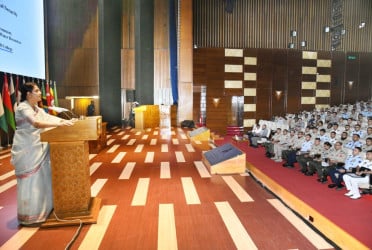Many journalists in Bangladesh are leveraging artificial intelligence (AI) in their individual work but institutional use in newsroom operations remains nominal, according to a new assessment revealed on Saturday.
The assessment titled "Media Metamorphosis: AI and Bangladeshi Newsrooms 2024" is an outcome of a survey of 53 journalists from 25 news outlets along with focus group discussions (FGDs) and key informant interviews (KIIs) involving 13 editors and newsroom gatekeepers from print, television and online news platforms.
The assessment is part of an initiative by the Media Resources Development Initiative (MRDI) with support from "Digitally Right" and funded by The Asia Foundation with an aim to understand AI usage patterns, addressing ethical concerns and identifying needs and gaps for improved AI adoption in Bangladesh's news media.
An assessment finding sharing ceremony titled "Assessment of AI integration in Bangladeshi news media" was organised at The Daily Star building in the capital.
Editors, newsroom gatekeepers, head of online platforms of news outlets, journalists, academics, fact-checkers and representatives from the CSOs and development sector joined it.
Miraj Ahmed Chowdhury, Managing Director of Digitally Right and Maliha Tabassum, an Assistant Professor of Department of Mass Communication and Journalism at Bangladesh University of Professionals jointly presented the assessment findings at the programme.
The survey finds that 51% of journalists have used AI tools in their work individually, but institutional use is much lower at just 20 percent.
Among those using AI, ChatGPT is the most popular tool with a 78% usage rate, followed by Grammarly (52%) and Google Translate (44%). Other tools include Canva (37%), Google Gemini (19%), DALL-E and Adobe Sensei (15% each), and Midjourney, Tableau, Factmata, and Turnitin (7% each) along with 11% using other tools.
The primary use of AI across news media outlets is to enhance grammar and writing style with a combined usage rate of 52%.
Journalists using AI mainly rely on it for content enhancement and fact-checking. Following grammar improvement, conducting research and background verification ranks second at 48%.
Hasibur Rahman, Executive Director of MRDI, said that this initiative tries to understand current AI usage patterns in Bangladeshi newsrooms and explore future possibilities as part of MRDI's one of the strategic objectives to support the news media in their digital transformation.
Miraj Ahmed Chowdhury, in his presentation, emphasised the importance of ethical and responsible AI usage, the role of transparency through disclosure and the need of organisational policies governing AI applications. He also addressed the lack of structured AI integration in Bangladeshi newsrooms and the potential for embedding AI into daily workflows.
During the survey, about two thirds of the participants found that using AI increased their efficiency and improved their content quality while 52% reported that it reduced their workload. Half of the participants believe that AI will improve their journalism quality significantly in future.
In terms of associated concerns, the assessment finds that concerns about AI causing job loss are moderate with most participants rating it 3 out of 5. However, there is strong concern that over reliance on AI may reduce critical thinking and affect the reliability of content.
The assessment highlighted that journalists exhibit a strong resistance to technological change, particularly AI perceiving it as a threat rather than a tool creating a self-imposed barrier that hinder innovation in newsrooms.
Additional challenges include surface level understanding, a focus on output over process, lack of understanding about incorporating AI into workflows and guidelines, and a fear of making mistakes that overshadows the desire for innovation.
About the ethical use, most participants however said they are unaware of awareness on ethical use of AI revealing participant's unfamiliarity with global or industry-specific guidelines governing the ethical use of Al in journalism.
The surveyed journalists pointed out major barriers to ethical AI adoption include insufficient training and support (85%), lack of AI understanding (74%), budget constraints (47%) and absence of clear ethical guidelines (45%).
In an open discussion on Saturday as part of finding sharing meeting, participants shared their experiences with AI discussing both its benefits and the concerns associated with its use.
One common challenge from the newsroom was all management's verbal support and commitment towards AI adoption but lukewarm response in funding.
Credibility of AI-generated content and its acceptance to audiences were also discussed.
They suggested implementing a disclosure policy for AI usage and creating internal guidelines, incorporating AI topics into existing university courses until a dedicated curriculum can be established and highlighting opportunities for AI beyond content creation such as in website traffic management, targeted advertising and SEO optimization.
To shift mindset and present AI as a catalyst for newsroom evolution, the assessment recommends developing comprehensive guidelines, establishing transparent AI disclosure, implementing tired training programs and modernizing journalism education.
Bd-pratidin English/ Afia
































































